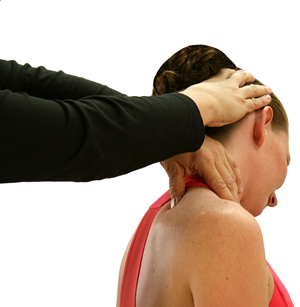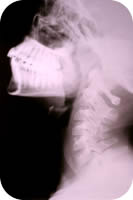Icing for Initial Self-Treatment
Treatment can begin after major injuries such as fractures have been ruled out.
For the first 72 hours ice should be used to reduce pain, inflammation, and swelling
- Rest – Avoid putting additional stress on the neck.
- Ice – Apply ice to the neck and shoulder for 20-30 minutes, every 2-3 hours, until the swelling is reduced.
In addition, non-steroidal anti-inflammatory drugs (NSAIDs) are often prescribed to control pain and inflammation during this initial phase.
After completing this initial acute stage, implementation of ART treatments should begin as soon as possible.
Scar Tissue Forms Fast
The formation of scar tissue, both on the surface, and within your body, is part of your body’s natural healing process, and is required for the initial healing of your damaged tissues.
These microfibers form strong meshes over damaged areas and act to help support those structures while your body is healing itself.
However, excessive scar tissue formation can cause layers of tissues to bind together (forming adhesions) and result in restricted ability to move, nerve compression, and a variety of other problems.
An Example of the Impact of Scar Tissue on Your Body
When one considers just how quickly fibrotic tissue (scar tissue) forms within damaged tissue (7 days), it becomes clear that early soft-tissue intervention is essential.
For example, let us look at just one structure – The Anterior Scalene.
- The anterior scalene extends from the vertebra of the neck to the second rib (TP’s C3-C6 to scalene tubercle first rib, anterior surface second rib).
- Research has shown that after a hyper-extension/hyper-flexion injury, the anterior scalene often becomes fibrotic.
- When this muscle becomes fibrotic it can cause compression on a network of nerves known as the brachial plexus.
- Compression of the nerves in the brachial plexus can create the neurogenic thoracic outlet syndrome (NTOS) which causes neck pain, headaches, altered sensation (paresthesias), and weakness in the shoulders, arms, wrists, and hands.
- Some studies (4) have shown that NTOS causes a decrease in quality of life equivalent to that of those suffering from Chronic Heart Failure.
It is interesting to note that many compression injuries to the brachial plexus do not show up for 7 to 37 days after the injury. By applying manual therapy procedures (such as Active Release Techniques) early in the healing process, it is possible to avoid the formation of excessive scar tissue in these structures, and thereby reduce the impact of conditions such as NTOS.
(1. Diagnosis of thoracic outlet syndrome Journal of Vascular Surgery Volume 46, Issue 3, September 2007, Pages 601-604. Richard J. Sanders MD, Sharon L. Hammond MD and Neal M. Rao BA
2. Biomechanical and histological evaluation of muscle after controlled strain injury Am J Sports Med 1987 15: 9 Pantelis K. Nikolaou, Beth L. Macdonald, Richard R. Glisson, Anthony V. Seaber and William E. Garrett, JR
3. Symptoms and Signs of Irritation of the Brachial Plexus in Whiplash Injuries J Bone Joint Surg (Br) 2001 Mar;83(2):226-9 Ide M, Ide J, Yamaga M, Takagi K
4. Surgical intervention for thoracic outlet syndrome improves patient’s quality of life. Chang, D.C., Rotellini-Coltvet L.A., Mukherjee D, et al.,J Vasc Surg, 2009. 49(3): p. 630–5;discussion 635–7.)
Using ART to Treat Whiplash Injuries
Active Release Techniques is one of the most effective techniques available for treating whiplash injuries, even whiplash injuries that occurred sometime in the past.
Early implementation of ART treatment procedures can prevent acute injuries from becoming chronic problems.
In the case of whiplash injuries research has shown that 15% to 40% of individuals who have had these injuries develop chronic neck pain.(1) Early intervention can help you avoid becoming one of these statistics.
(1. Chronic whiplash and whiplash-associated disorders: An evidence-based approach Journal of the American Academy of Orthopedic Surgeons October 2007;15(10):596-606 Schofferman J, Bogduk N, Slosar P.)
Take Care of the Entire Kinetic Chain
 Although early intervention is important, it is equally important to have the practitioner consider all the areas that are, or could be, damaged in a hyper-extension, hyper-flexion injury.
Although early intervention is important, it is equally important to have the practitioner consider all the areas that are, or could be, damaged in a hyper-extension, hyper-flexion injury.
The practitioner must look for damage in more than just the neck, and review possible injuries to the patient’s jaw, shoulders, arms, wrists, upper-back, lower-back, hips, and sometimes even the lower extremities. Areas that have been injured often do not show symptoms for several weeks.
This is often the case with jaw problems caused by whiplash injuries. With whiplash injuries, one in three people who have been in a hyper-extension hyper-flexion accident will develop delayed TMJ problems.(1)
(1. Delayed temporomandibular joint pain and dysfunction induced by whiplash trauma: a controlled prospective study Journal of the American Dental Association August 2007;138(8):pp. 1084-91 Salé H, Isberg A.)
From a kinetic chain perspective, jaw motion and neck motion are directly linked to each other. Activation of neck and jaw muscles occurs simultaneously, with synchronized movements of the TMJ, cervical spine, and the atlanto-occipital joints (The Atlanto-occipital joint lies between the base of the skull (occiput) and the C1 vertebra (atlas))(2).
(2. Deranged jaw–neck motor control in whiplash-associated disorders European Journal of Oral Sciences, February, 2004; 112: 25–32. Per-Olof Eriksson, Hamayun Zafar, Birgitta Haggman-Henrikson)
Thus any injury to muscles of the neck can directly affect jaw function. It becomes much easier to resolve Whiplash Injuries when your Active Release practitioner takes into account this type of kinetic chain relationship.
Which leads me to an important point, you need to find an ART practitioner who is certified in biomechanics, as that could make a huge difference in resolving your condition. Practitioners with a strong biomechanics training will have a better understanding of kinetic chain relationships can more easily identify structures that are involved in the injury. See Find an ART Practitioner to find a qualified practitioner in your area.
Exercises for Whiplash Injuries
Appropriate exercise plays a critical role in the rehabilitation plan of any whiplash injury. Initially, exercises should be performed within a range-of-motion that is pain-free, or causes very minimal pain. Staying in this range will help to ensure:
- That no abnormal neurological motor responses are being created.
- Time enough to allow for complete tissue repair of the injured area.
It is very important to remember that injured tissue needs time to remodel, but without the right exercise, the possibility of re-injury is very high. See our Blog about “Exercise and Tissue Remodeling”.
If you are looking for a series of exercises specifically designed to rehabilitate the neck after a whiplash injury, then you should check out our Release Your Kinetic Chain series of exercise books. We have achieved great results in the treatment of whiplash injury patients by using the exercises in the Exercises for the Jaw to Shoulder book. This book covers several of the main areas commonly injured in a hyper-extension hyper-flexion injury.
Dr.Abelson’s international best-seller – Release Your Pain – can help you better understand the causes of neck and back pain, its effects upon the structures of your neck, and provides exercises to help you remodel your tissues after an injury..
Visit our website at www.releaseyourbody.com to purchase your eBook or hard-copy.
Nerve Flossing Exercises and Videos
When nerves are entrapped, your body will go to great lengths to protect these nerves. Muscle function is often reduced, including reducing the amount of force that certain muscles can generate. This creates muscle imbalances and abnormal neuromuscular responses, and can impact other structures in the kinetic chain as they attempt to compensate for these weaknesses.
Appropriate nerve flossing exercises can help to restore normal neuromuscular patterns, increase strength, range-of-motion and restore normal motion patterns. Flossing a nerve is like flossing your teeth, except that your nerve is the floss that is moving through the restricted tissues.
In addition to the Active Release protocols that a certified ART practitioner will use, there is also several simple nerve flossing exercises that can be performed at home to help reinforce these treatments.
Watch the following videos for examples of nerve flossing videos that we use at our clinic. Click the left and right arrows to scroll through the videos.
- Nerve Flossing – Spinal Cord and Sciatic Nerve
Releasing both the spinal cord and sciatic nerve. This nerve flossing video gives you several ways to mobilize entrapped nerve roots and the sciatic nerve.
Play Video
Click To Play
- Nerve Flossing – Spinal Accessory Nerve
In this video we discuss the Spinal Accessory Nerve and show you a nerve gluiding exercise you can use.
Play Video
Click To Play
- Nerve Flossing – Axillary Nerve
In this video we discuss the Axillary Nerve and show you a nerve gluiding exercise you can use.
Play Video
Click To Play
- Nerve Flossing – Suprascapular Nerve
In this video we discuss the Suprascapular Nerve and show you a nerve gluiding exercise you can use.
Play Video
Click To Play
PreviousNextPreviousNext
Exercise Blogs for Whiplash
Click on the following blog articles for additional information on Whiplash Injuries.
The first factor to consider is that Whiplash injuries (hyper-extension, hyper-flexion injuries) occur in an extremely short period of time. Most of these injuries occur in about one-quarter of a second. This means that the occupants of a vehicle which is struck from behind do not have time to react to the accident. Keep this time-frame in mind as we cover some of the actions that occur.
After major injuries such as fractures have been ruled out, treatment can begin. For the first 72 hours ice should be used to reduce pain, inflammation, and swelling. See our section on the correct procedures for icing. After this initial acute stage, implementation of ART procedures should begin as soon as possible.
Neurological Impact of the Neck’s Kinetic Chain
Whenever an injury occurs in your neck (such as a sprain/strain), it damages not only the ligaments, tendons, and muscle fibres, but also their embedded neurological structures (Golgi tendon organs, muscle spindles, and joint receptors). These neurological structures play an essential role in postural control.


